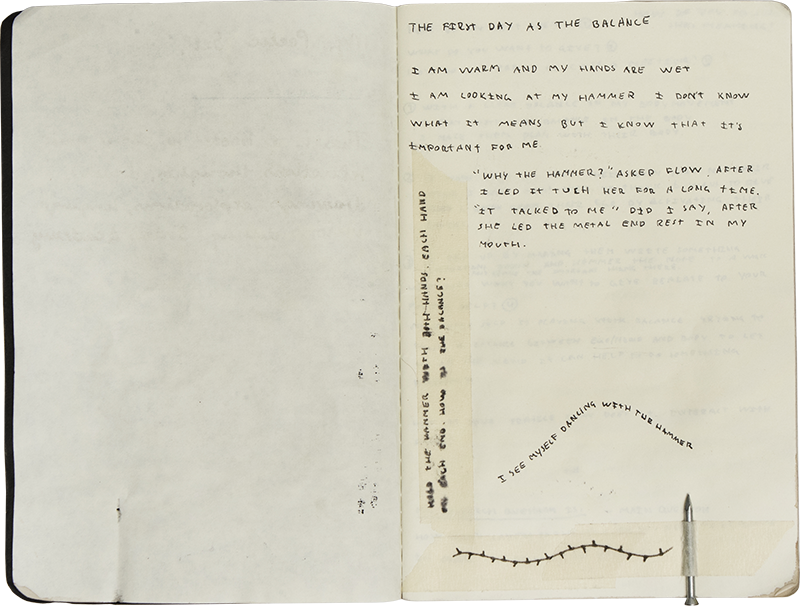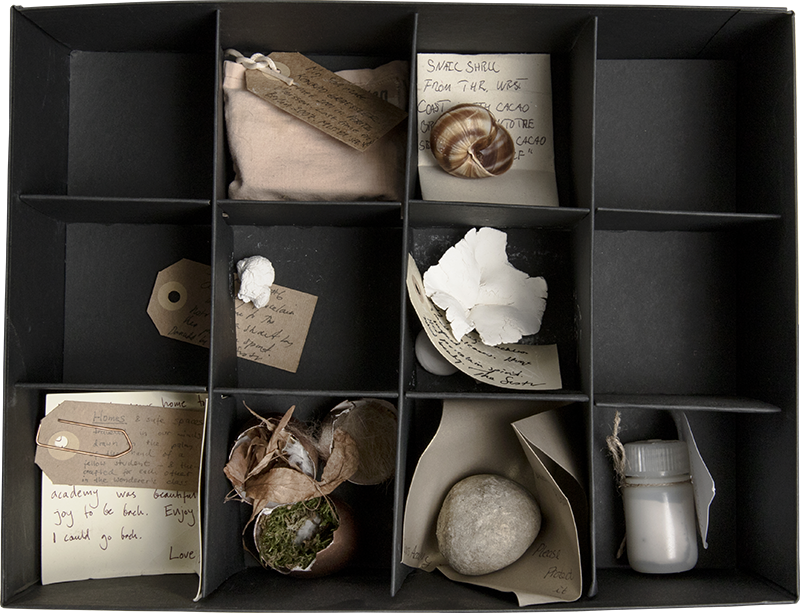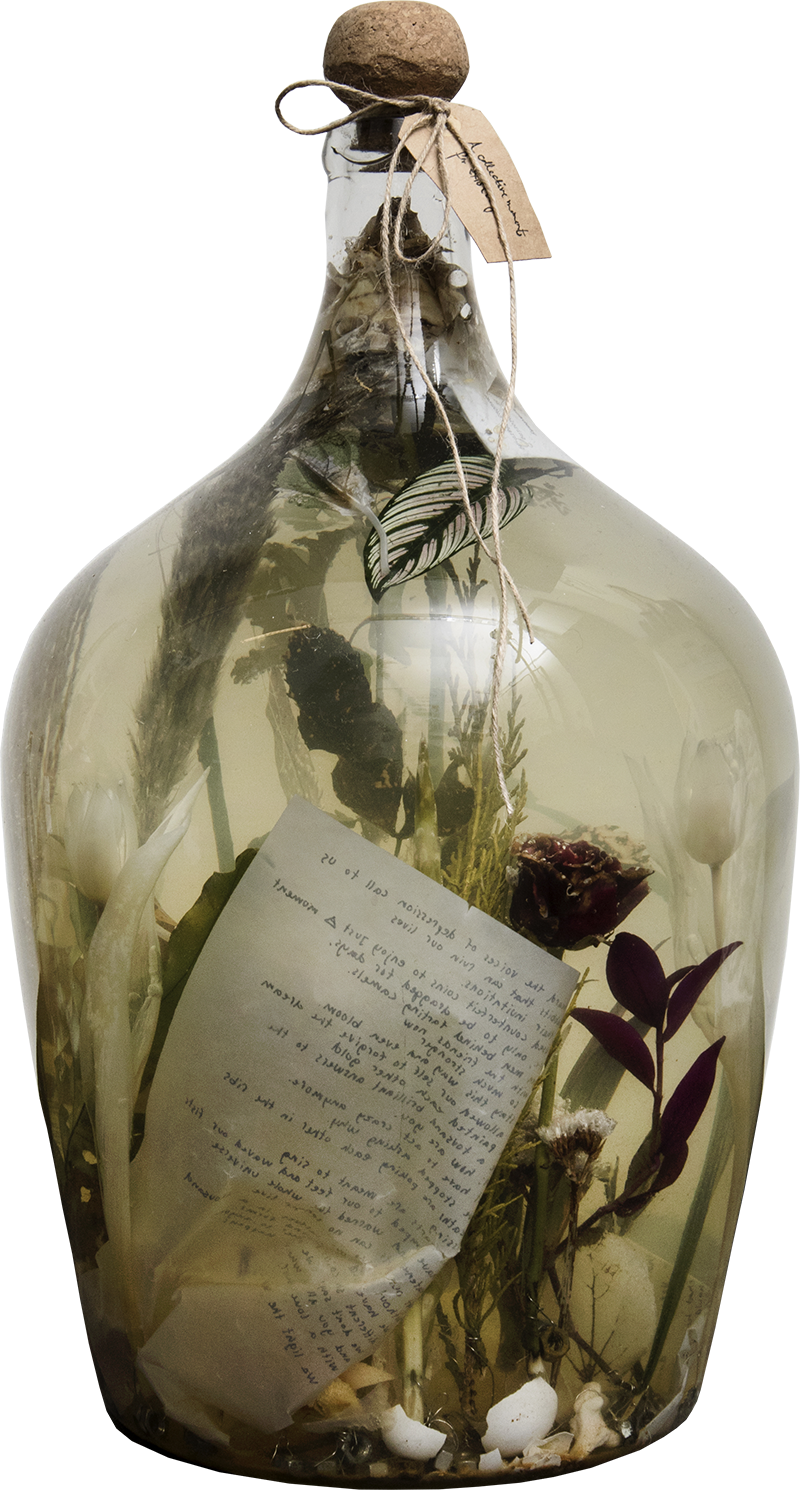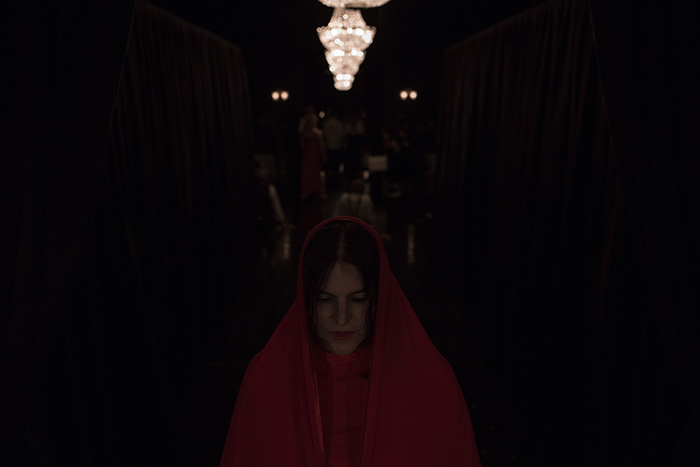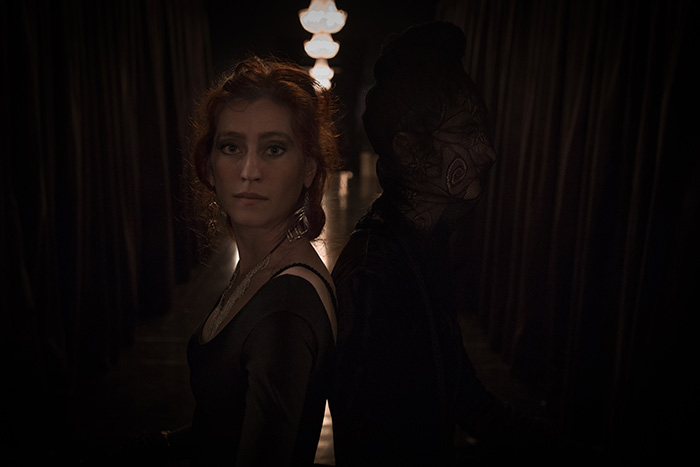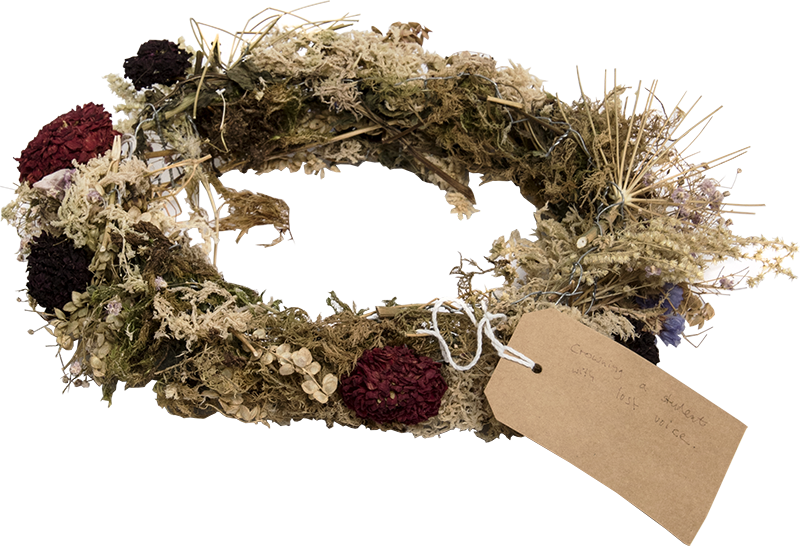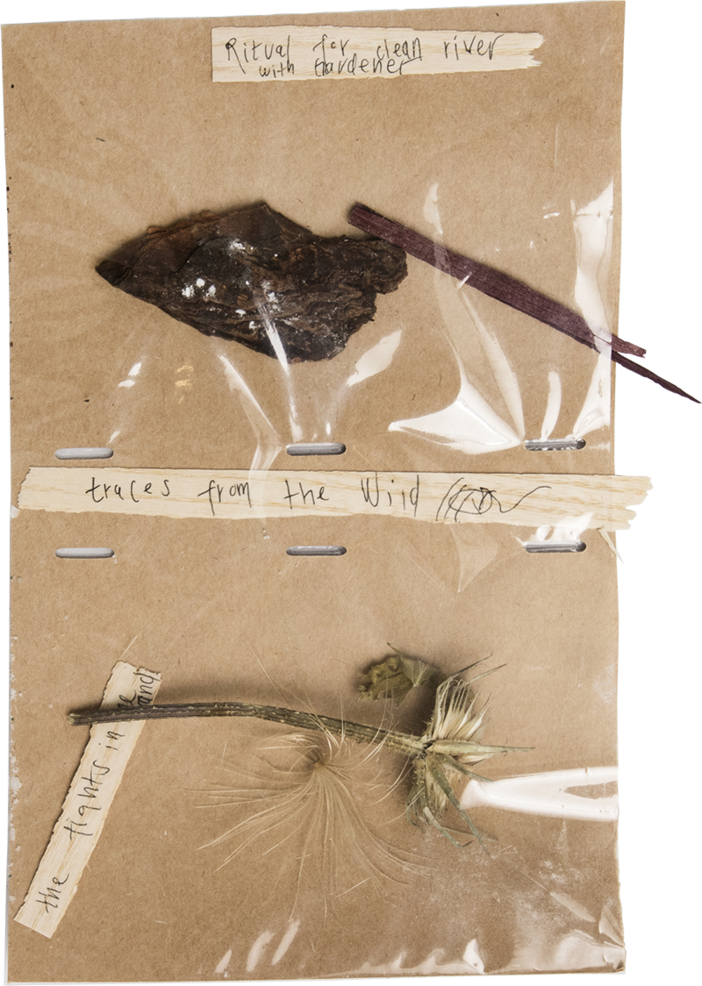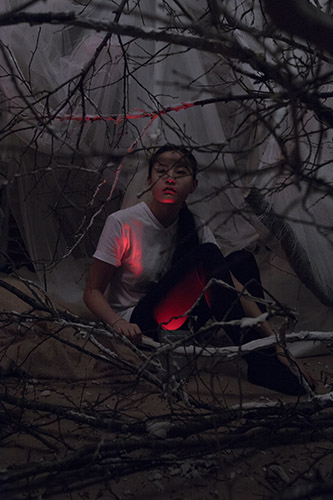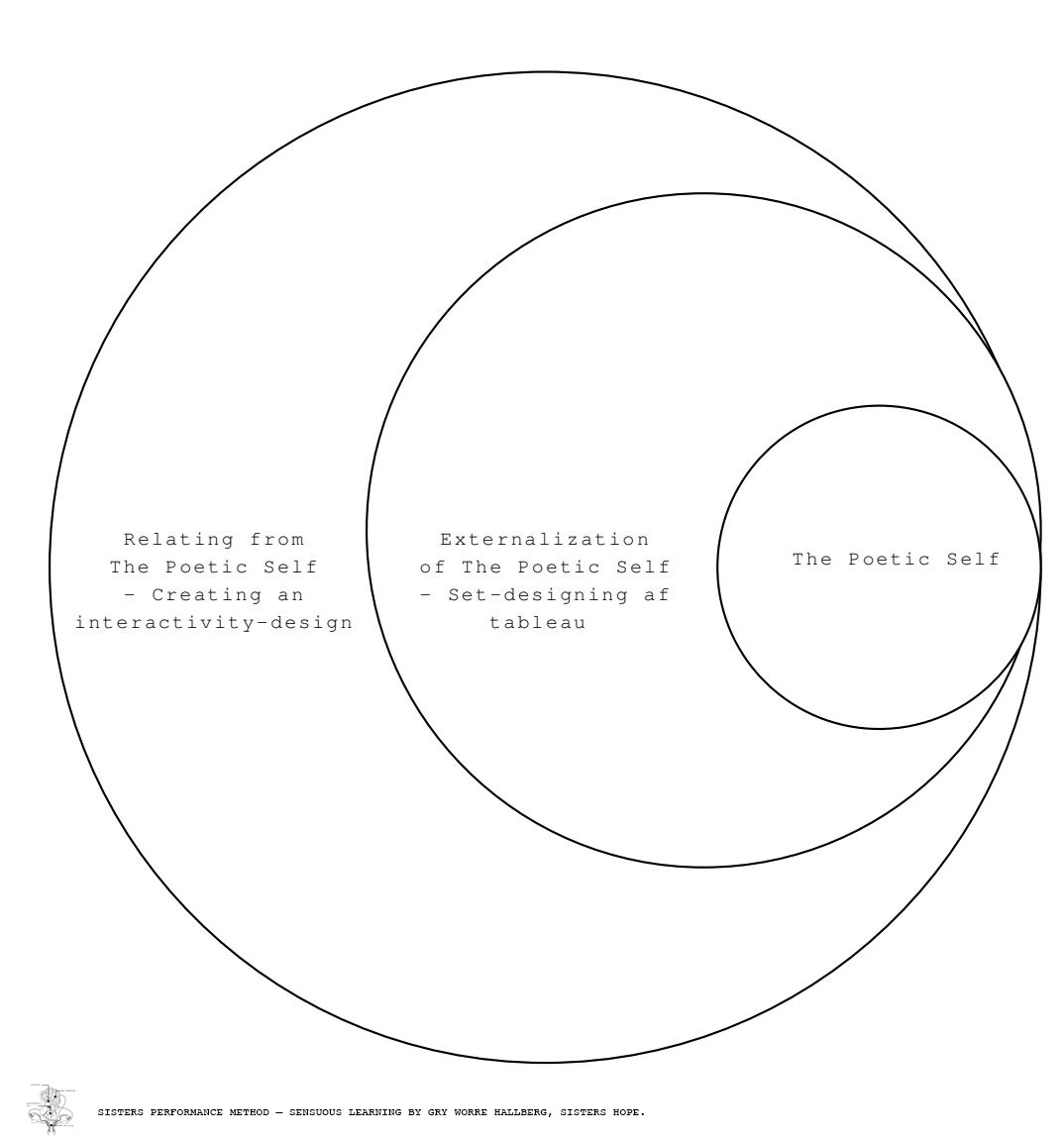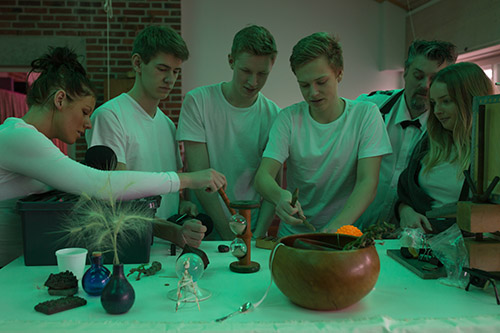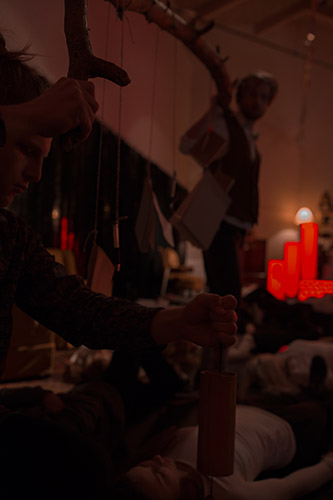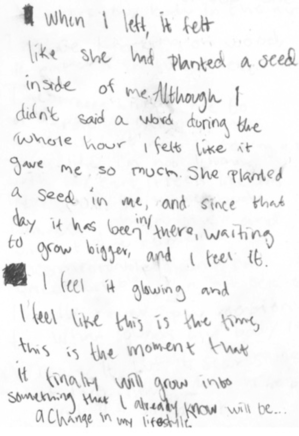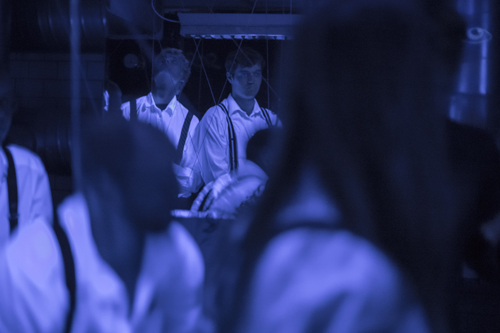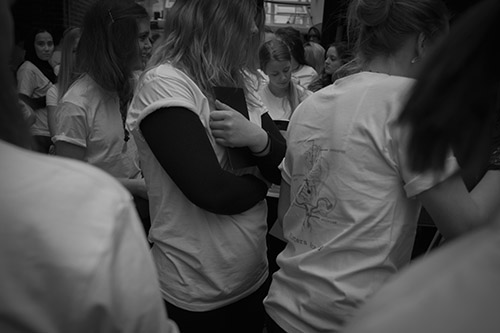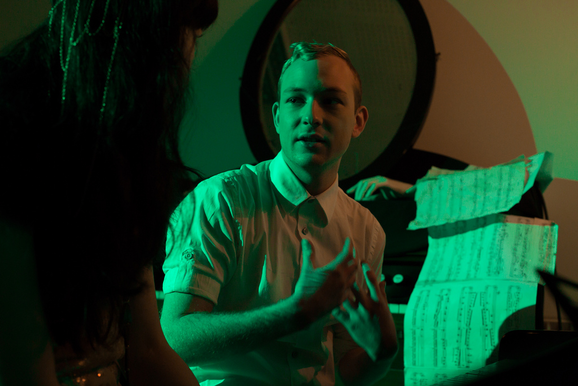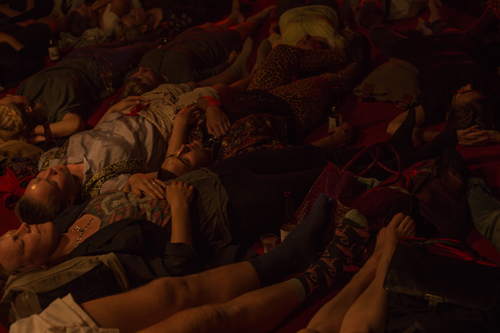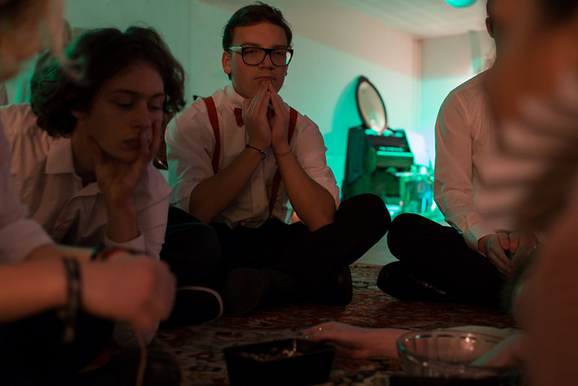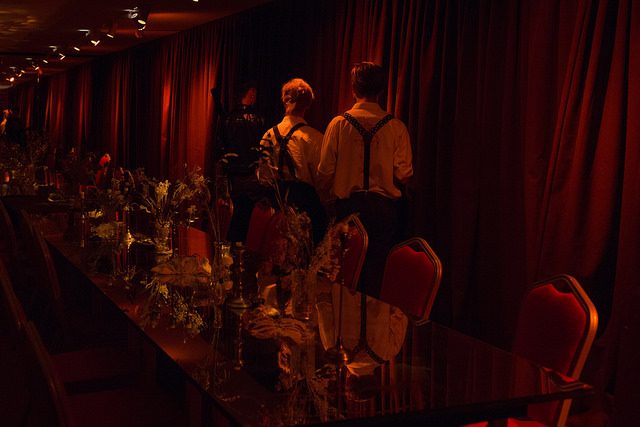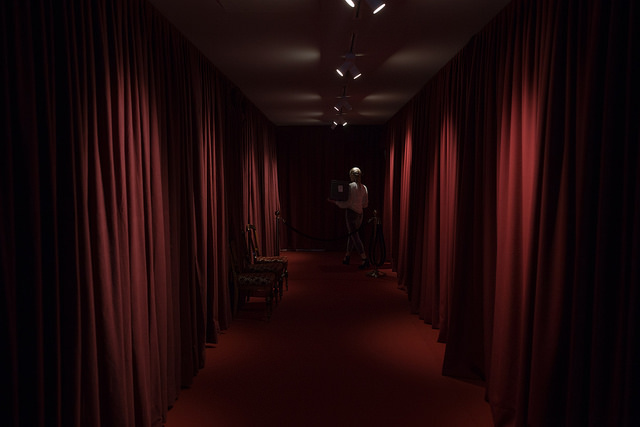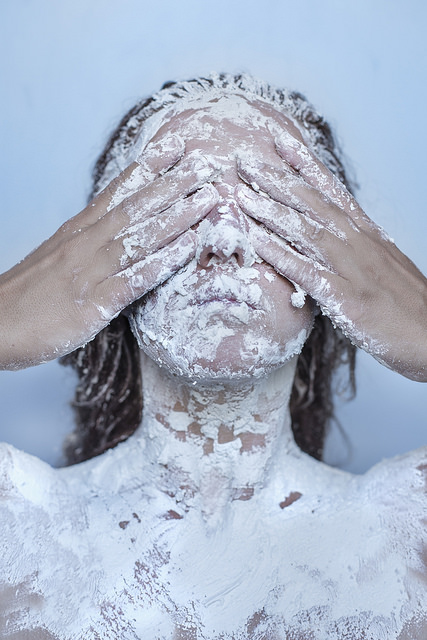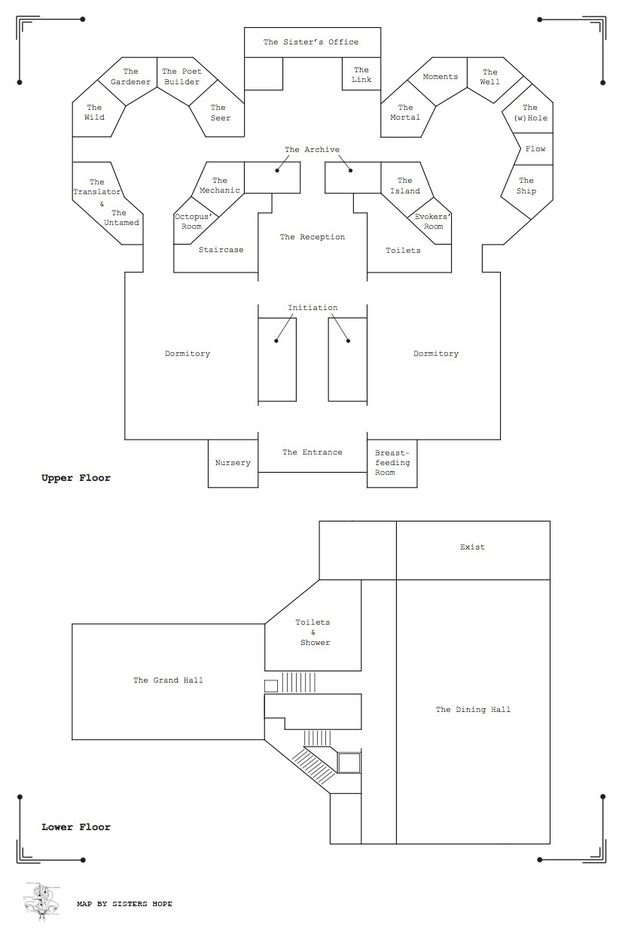Sensuous Society Manifesto: Sensuous Society - A potential new world beyond the economic, ecological and democratic crisis. Se the video here or read the Sensuous Society manifest here.
Bibliography
- Arlander, Annette: Practicing art - as a habit?, in: Ruukku Studies in Artistic Research, 7 doi.org/10.22501/ruu.292065, 2017 (accessed 17.10.2018)
- Arlander, Annette: Artistic Research as Speculative Practice, jar-online.net. doi.org/10.22501/jarnet.0001, 2017 (accessed 28.09.18)
- Arlander, Annette: Artistic Research and/as Interdisciplinarity, in: Artistic Research Does #1, Porto: Faculty of Fine Arts University of Porte, 2016
- Adorno, Theodor W. og Horkheimer, Max: Oplysningens dialektik, København: Gyldendal, 2001 (1947)
- Bateson, Gregory: Steps towards an Ecology of Mind, Chicago: University of Chigaco Press, 1972
- Baumgarten, Alexander Gottlieb: Filosofiske betragtninger over digtet, 1735 (æstetik-begrebet barsles iflg. Kjørup (2005)
- Baumgarten, Alexander Gottlieb: Aesthetica, 1750 – 1758
- Bishop, Claire: Artificial Hells. Participatory Art and the Politics of Spectatorship, London and New York: Verso, 2012
- Borgdorff, Henk: The Production of Knowledge in Artistic Research, in: The Routledge companion to research in the arts, London: Routledge, 2011
- Bourriaud, Nicolas: Relationel æstetik, København: Det Danske Kongelige Kunstakademi, 2005
- Böhme, Gernot and Thibaud, Jean-Paul: The aesthetics of atmosphere, London and New York. Routledge, 2017
- Campbell, Joseph: The Power of Myth, New York: Achor Books, 1991
- Darsø, Lotte: Learning Tales of Arts-in-Business, Frederiksberg: Samfundslitteratur, 2004
- Drotner, Kirsten: Æstetik: Pædagogik eller kunst?, in: At skabe sig – selv, København: Gyldendal, 2001
- De Oliveira, Nicolas: Oxley, Nicola & Petry, Michael: Installation Art, London: Thames & Hudson, 1994
- De Oliveira, Nicolas: Introduction, in: Installation Art in the New Millennium – the empire of the senses, De Oliveira, Nicolas; Oxley, Nicola & Petry, Michael (ed.), London: Thames & Hudson, 2003
- Dorthe, Jørgensen: Den Skønne Tænkning, Aarhus: Aarhus Universitetsforlag, 2014
- Drotner, Kirsten: Æstetik: Pædagogik eller kunst?, in: At skabe sig – selv, København: Gyldendal, 2001
- Gade, Solveig: Rammen om værket i verden – Relationelle og intervenerende strategier i samtidskunsten, Ph.d.-afhandling, Teatervidenskab v/ Institut for Kunst og Kulturvidenskab, Humaniora, KU, 2008
- Göthlund, Anette, Illeris, Helene, Thrane, Kirstine W.: Edge: 20 Essays on Contemporary Art Education, Copenhagen: Multivers Academic, 2015
- Hallberg, Gry Worre and Darsø, Lotte: Using Performance to Foster Inherent ‘Poetic Potential’ in Nordic Schools, forthcoming
- Hallberg, Gry Worre: Sensuous Learning, TEDx, 2015: www.youtube.com/watch?v=-JV1tWsDZaw (accessed 12.12.2018)
- Hallberg, Gry Worre and Lawaetz, Anna: Sisters Hope - Protected by Fiction. Between Art and Pedagogy, in: CCC, Issue 1 #Novelty, 2011
- Hallberg, Gry Worre: I Need My Shot of Fiction!, Master Thesis, Theatre- and Performance Studies, Department of Arts and Cultural Studies, Faculty of Humanities, University of Copenhagen, 2009
- Haseman, Brad: A Manifesto for Performative research, Media International Australia incorporating Cultur and Policy, theme issue “Practice-led Research” (no. 118): pp. 98 – 106, 2006
- Illeris, Helene: The poetic self is not a fiction – undersøgelser af æstetisk erfaring i kollektive læreprocesser med samtidskunst, in: Æstetik og Pædagogik. København: Akademisk Forlag, 2018
- Illeris, Knud: How we learn. Learning and non-learning in school and beyond, London and New York: Routledge, 2006
- Kjørup, Søren: Teorien om den fornemmede erkendelse. Om hvordan æstetikbegrebet blev til, in: Æstetisk erfaring – tradition, teori, aktualitet (red.) Thyssen, Ole, Frederiksberg: Samfundslitteratur, 2005
- Kjørup, Søren: Kunstens filosofi - en indføring i æstetik, Roskilde: Roskilde Universitetsforlag, 2000
- Krøgholt, Ida: Når fiktionen spiller hovedrollen, in: Tidsskriftet Uddannelse nr. 2, 2002
- Leavy, Patricia: Method Meets Arts. Art-Based Research Practice, New York: The Guilford Press, 2009
- Lehmann, Niels Overgaard: Pragmatisk dualisme: dannelse mellem rationalitet og rationalitetskritik, Johansen, M.B. (Redaktør), in: Dannelse, Århus: Århus Universitetsforlag, 2002
- Machon, Josephine: Immersive Theatres. Intimacy and Immediacy in Contemporary Performance, Hampshire: Palgrave Macmillan, 2013
- Marcuse, Herbert: Eros & civilisation, London: Sphere Books, 1970 (1955)
- Marcuse, Herbert: De nye kontrolformer og Sejren over den ulykkelige bevidsthed. Repressiv afsublemering, in: Det én-dimensionale menneske, København: Gyldendals Uglebøger, 1980 (1964)
- Massumi, Brian: The Politics of Affect. Cambridge: Polity Press, 2015
- Nelson, Robin: Supervision, Documentation and Other Aspects of Praxis in Practice as Research in the Arts – Principles, Protocols, Pedagogies, Resistances, London: Palgrave Macmillan, 2013
- Nietzsche, Friedrich: Tragediens fødsel, København: Gyldendal, 1999 (oversat fra 3. udgaven 1886)
- Reason, Matthew: Archive or Memory?: The Detritus of Live Performance in: New Theatre Quarterly, Cambridge: Cambridge University Press, 2003
- Schwab, Michael: Transpositions, Leuven: Leuven University Press 2018
- Thompson, Nato og Sholette, Gregory: The Interventionists: Users’ Manual for the Creative Disruption of Everyday Life, Sholette og Thompson (red.), Massachusetts: The MIT Press, 2004
- Turner, Victor: The Ritual Process: Structure and Anti-Structure, Aldine Transaction, 1995 (1969)
- Turner, Victor: Dramas, Fields, and Metaphors: Symbolic Action in Human Society, NY: Cornell University Press 1975
- Van Gennep, Arnold: The Rites of Passage, Chicago: University of Chicago Press, 1960 (1909).
- Zournazi, Mary: Navigating Movements. A Conversation with Brian Massumi, in: Hope, London and New York: Routledge, 2002
Other web-references:
QR, Sisters Academy – The Boarding School, Den Frie Center of Contemporary Art:
gallery.mailchimp.com/c8a9c7473497d27daa9701d77/files/3aba4002-8918-4883-bd73-529c758495de/QR.pdf
How Sensuous Learning supports a transition towards a more sustainable future
The ecological mind as defined by Bateson (1972) is the awareness of the interconnectedness of our mind and nature, even though our language and culture, as shaped during The Enlightenment and The Industrialization, wants us to understand these to be separated – A very dualistic approach. The poetic mind activates a more holistic awareness and approach in that we activate other modes of experience and perception, more specifically a more sensuous awareness, here within, our understanding of the connectedness to nature. When we sense and embody this connectedness we will also be aware of how the destruction of nature is also a process of self-destruction.
Sensuous Learning is the innovations that are happening in the classroom of the teachers at the school, it is the practices unfolded by the performers, and due to the overall sensuousness of the space and the vision of a Sensuous Society as a guiding principle, it infiltrates every aspect of the school during Sisters Academy. These Sensuous Learning innovations live in the ones who have taught them and the once who have received these teachings and in everyone who is submerged into the overall sensuous ambience as atmosphere of the universe of Sisters Academy.
Our ‘archive of detritus’ and beyond witnesses how Sensuous Learning evokes deep and transformative learning experiences and how it stimulates the sense of connectedness that might at least one of the answer to a more sustainable future.
I was once asked how I knew I had fallen in love. ”Why, it was when every day became poetry,” I replied.
How would it feel then, to live as if you were always in love? That’s what I experienced at the Sisters Academy.
Nothing was an accident at the Academy. A gorgeous, glimmering serendipity was everywhere, but accidents? None. Almost getting lost as one first entered the Academy, stumbling a little blindly through the thick, dark, heavy, fringed masses of curtains that constituted the ”Vagina”. Eggs scattered everywhere, carefully set outside the teacher’s doors, cooked into the meals, lying in forms of crystal, glass and fiber throughout the Academy’s many levels. A steady hum of soft voices, improvised song and tapestry-like conversations warmed up the womb at all hours. We stewed and grew, all of us, like the sweet succulents in the Gardener’s room. Each class watered us hungry little seeds, each teacher sang a song of love in the garden of our souls. Our beds were a series of connected cradles, placed in neat rows in a carefully darkened room. Our birth loomed both heavy and light before us.
Our poetic selves waited for us to find them through broken mirrors. The Academy didn’t try and pass itself off as a utopia, but rather offered to balance the lack of emphasis on the aesthetic dimension that the ”outside world” is so marked by, particularly in the capitalist, consumerist, industrialized Western world. For three weeks it existed to challenge, elate, and push to the limit all those who dared to enter its doors. Birth is no painless experience, and I didn’t go a day without experiencing an astringent, cloying combination of longing, euphoria and the emergence of suppressed memories that occasionally brought me to my knees. Facilitated by our amazing teachers, each sense was at constant and heightened attention. One was an ephemeral veil of lace, another a dancing flame. One walked and danced like a queen, yet another offered to paint you with his gaze from the shadows. I found the poetry that had spoken to me my entire life sang in loud, unafraid, shining verses around and around my head, in circles of light and shadow. It was the song of my rebirth, of finding my twin through my poetic self.
SENSUOUS LEARNING
Introduction
“… Like an arm cut of we move forward in the ever-turning efficient wheels of society without noticing the blood floating from our armpits. We need to democratize the aesthetic mode of being to overcome the longing and suffering that its general absence … creates. The aesthetic dimension will serve as a key source of inspiration in the Sensuous Society.”
- The Sensuous Society Manifesto
Sensuous Society demonstrates a potential future world and society where, contrary to the current domination of economic rationalism, the sensuous and poetic mode of being is at the centre of all action and interaction. Sisters Academy is a large-scale durational project, in which I am exploring what the school of a Sensuous Society might be with my performance-group Sisters Hope - Sensuous Learning. It has currently unfolded primarily in the Nordic region and in two different large-scale formats - Respectively: Sisters Academy - The Takeover and Sisters Academy - The Boarding School.
In The Boarding School we create an actual sensuous boarding school at a collaborating art institution. Anyone can purchase a ticket and enroll as a student for at least 24 hours to co-explore new modes of Sensuous Learning with us. As a student you will get a bed, three meals a day, participate in morning and evening rituals and gatherings and Sensuous Learning classes. As performance staff we live at the school, night and day, in our Poetic Selves, for the entire duration of the manifestation – eg. four weeks the last time we manifested at Den Frie Center of Contemporary Art in Copenhagen.
In The Takeover we take over the leadership of a series of real upper secondary schools. We transform the school completely through set-, light- and sound-design and inspire the teachers of the school to innovate their classes to evoke Sensuous Learning. The schedule continues but all classes must now be taught sensuously – E.g. an exploration of – What is sensuous Math by the Math teacher? The lived findings of the experiment Sisters Academy are Sensuous Learning contributions.
“I feel free, beautiful, happy. Blown away by playfulness. It makes me feel like I am myself, actually inside of my own body. Like I am part of it. it also felt like I was moving without intention or thought. But where did all of the movements come from if not from my mind? From my memory? My body’s own memories? From my soul? Poetic Self? Heart? Maybe it comes from something we could never understand through words, only by feeling”
- Student notebook, Sisters Academy – The Takeover
Her name was the Moon. I realized it at the very first Evening Gathering, led in the most beautiful, nurturing whisper by none other than the Sister herself. All my life I’ve been a child of the sea. The moon has special significance in my religion—literally given to us by God to guide us. And I have traveled in blurry, bright circles all my life. Certainly now when I had fallen in love with Sweden during an exchange semester, returned to my country of origin, and come back to Sweden yet again after the longing became unbearable. Next month, after nearly three years, I’ll leave Sweden again (whether it’s for once and for all or just another arc in the cycle is to be seen). I’ve gone through phases darker than I could have imagined for myself, and emerged each time, painfully but surely in the growing light. When the Sister asked us to consider how our poetic selves behaved in space, I realized what is and must always be true for myself. No matter how small and dark I can feel, I BELONG in space, sharing the light that will certainly come. And how much lovelier a night is when it is moonlit. So lovely that the impression of it stays long after the moon has disappeared.
The moon is shining impossibly bright right now. I am overwhelmed with love and gratitude for all my teachers, and all my fellow students, who provided an environment of generosity, honesty and compassion at every step. Who cried and laughed with me, and stroked my hair and spoke to me of bees and kissed my face and sang until our voices twisted around each other like moonflower vines. I will remember what happened at the Academy for as long as the Moon swims the seas of the galaxy.
I made a promise to myself at the Academy, to no longer let myself be imprisoned by time, by an artificial sense of impending anything. If we must speak of time, I will say that two (infinity) days passed unawares and yet shone with a diamond light through each moment, like the moon itself. Suddenly it was time to begin the exit ritual. To be born. My hands were washed slowly and sweetly in oils that smelled of myrrh and jasmine. I donated a small, paper part of an enormous experience to the Archive. My eyes blinded by a flood of light at the end of a dark, dark tunnel. Gold was brushed over my fingertips like a whispered secret.
I was dazzled by bright, gray skies as I left, taking one last glance at the beautifully impish Mortal and her dark, kohl-lined gaze as she shut the large, steel doors to the Academy, their industrial façade betraying nothing of the magic they contained. A weighty tiredness drew over me and I closed my eyes as I waited for the bus, feeling every bit the newborn cast [back] into the outside world.
On the bus ride home, a young man sat next to me. Remembering to be Untamed in small steps, I started a conversation with him. Right before we parted, he revealed he was a student of astronomy that would be present at the Observatory that evening. That I was welcome to meet him there. And as he left, I laughed with surprise, and delight. Of course he wanted to see me again—for I was the moon.
- Student blog-post, Sisters Academy – The Boarding School
Sisters Academy has been thoroughly documented from the beginning and all documentation has been collected in our archive -The Archive. Reason (2003) extrapolates ‘An Archive of Detritus’, which is his vision of an archive mimicking the positively valued characteristics of archives (preserving the live experience) and the memory (the individual preservation of the live experience) by accumulating the detritus of the performance (also see Nelson; 2013). The detritus of Sisters Academy consists of a multi-facetted scope of e.g. letter exchanges within the academy, gifts, notes passed around, objects left in corners and cracks of the Academy etc. Furthermore, The Archive includes analog student, staff and visiting artists/teachers/researchers notebooks (+ 2000), images, film and blogposts (text, sound files, images, film). The Archive also contains the findings in the Sensuous Learning classes described or preserved in other artifacts cf. Moments memory bottles from his Sensuous Learning class on memories or sand which was a central part of The Wild’s Sensuous Learning class etc. In combination with other evidence this provides a very full understanding of what is at stake in the practice and in the experience of it (Nelson, 2013, p.89) or in other words of what Sensuous Learning does. The Archive operates from within as it transports thousands of recorded in-situ-reflections on the sensuous experience and the Sensuous Learning situations out of the Academy.
Sensuous Learning as a conceptual frame, process-oriented tool and a novel performance and learning method
Sensuous Learning is a conceptual frame to explore the lived learning experiences that have been explored, unfolded and recorded in Sisters Academy. It is also a process-oriented tool evoked through the Sisters Performance Method, which is introduced to the teachers in the Takeover-format by which they innovate their classes to evoke Sensuous Learning and to my performers as the process framework of the Sensuous Learning classes they create.
Sensuous Learning is inspired by the conceptual framework of:
A vision: Sensuous Society.
A (research) question: How would you teach at the school of a Sensuous Society to stimulate Sensuous Learning?
A performative inspirational framework (immersion and intervention): We transform the school completely into the school of a Sensuous Society - A sensuous space in which we can conduct explorations of the question by embodying and inhabiting it.
A performance method: The Sisters Performance Method – Sensuous Learning: A method that evokes our ‘Poetic Self’ and open a new mode of being in the world, from which we can explore the question informed by the sensuous aspects of our being.
At the core of the Sisters Performance Method is The Poetic Self.
The Poetic Self is not a fiction or a character. We understand the poetic self as already existing inherent poetic potential. Through the Sisters Performance Method, we begin to discover and unfold this poetic potential. By doing so, most people experience a growing range of opportunities. Despite the fact that we are talking about a 'self', The Poetic Self is not essentialist, and on the other hand it is not a constructivist play of identity either - It is a third approach that may best be understood as an expansion of our potential through the connectedness to our inherent poetic mode of our being. It is an important point that we do not remove ourselves to make room for our Poetic Self. This third approach may be understood in a comparison to nothing less than the processes of and in the universe if we subscribe to the Big Bang theory; On the one hand it expands from one point (essentialism) and on the other hand there are an infinite number of parallel galaxies, parallel possibilities, within this universe (performative multitude). To me personally, it is also a space inviting the mystery and the 'unheimliche' - An exploration of the unknown territories, including that which is usually hidden in the dark. The opening of our poetic potential also opens the possibility of new modes of relationality and togetherness.
Theory and methodology
Theooretic framework
My understanding of ‘sensuous’ derives from the aesthetic philosophy of Baumgarten articulating the aesthetics as experience and recognition through the senses as opposed to the dominating logic-rational approach (1735, 1750 – 1758) or more specifically the interface of the experiential and reflective processes, which according to Baumgarten is the field of sensitivity (Jørgensen: 2014). My intention to investigate the role of the sensuous in a sustainable future is theoretically rooted in the civilization critique of the critical theory of (Marcuse; 1980 (1964), 1970 (1955), Adorno and Horkheimer; 2001 (1947)) of The Frankfurt School pointing towards the arts and the aesthetic dimension as a source of inspiration and an alternative approach in the creation and facilitation of societies.
In the creation of the performative framework we apply a ritual structures (rites de passage) (Van Gennep; 1909, Turner; 1975, 1995 (1969)) in order to support the engagement of the participants and the transformative potential of the experience. Rite des passage contains a pre-liminal, a liminal and a post-liminal phase. Transformation is at the core of the liminal phase, while the pre-liminal phase is the preparatory process to enter this space and the post-liminal phase is the incorporation phase where the new learning obtained during the liminal experience is integrated. Through the pre-liminal preparatory processes of entering Sisters Academy we open the participants up to take the experience in, and through the anchoring and integrating processes of departing Sisters Academy we invite the participants to reflect upon the experience and furthermore engage in the translation, integration and anchoring of the experience into their everyday life.
Furthermore immersion, intervention and interactivity are central performance strategies in my work.
I work with immersion as a visual and auditive space-changing strategy to create otherworldliness which liberates pre-cognitive and instinctive experiences and recognition impulses. In her introduction, Machon (2013) describes how there are several aspects to the word ‘immersion’ and its related forms: “… to ‘immerse’ is to ‘dip or submerge in a liquid’, whereas to ‘immerse oneself’ or ‘to be immersed’, means to involve oneself deeply in a particular activity of interest.” (Machon, 2013, p.21). She also explains how 'immersive' in artistic contexts has been developed from the computer world and describes what provides ”… information or stimulation for a number of senses, not only sight and sound” (Machon, 2013, p.21), in other words, activities where you are involved with your entire being. We use immersion to create a space of more sensuous and poetic character that might feel liberating due to its pre-cognitive nature and allow for intimacy in and with the experience (Jørgensen; 2014) and a mode of intensified presence (Massumi; 2015). Intervention to penetrate and implement the sensuous as the overall parameter both within and outside the art institution (Thompson and Sholette; 2004, Gade; 2008) and interactivity (Bourriaud; 2005, Bishop; 2012) to explore the potential of relating bodies actually living and experimenting together in an alternative world governed by aesthetic principles.
Sisters Academy - The Boarding School: In the Boarding School we create a boarding school as a large-scale immersive performance-installation where everyone with interest in the agenda can enroll as students to explore new modes of sensuous learning. Get a visual idea and fuller understanding of The Boarding School-format by watching this film at our vimeo from a manifestation at Den Frie in Copenhagen in the fall of 2017.
Sisters Academy - The Takeover: In the Takeover we take over the leadership of a series of actual upper secondary schools. Get a visual idea and fuller understanding of The Takeover-format by watching this film on our vimeo from a manifestation where we for two weeks early 2014 took over the leadership of the Danish upper secondary school, HF & VUC FYN FLOW.
The application of the ritual structure combined with the the performance strategies of immersion, intervention and interactivity seem to enable ‘deep learning’.” (Hallberg and Lawaetz, 2011). Deep learning may also be understood as transformative learning in that transformative learning is defined as learning that “… completely changes prior knowledge and permeates a person’s mindset or worldview profoundly, a process that can be painful and often touches on the existential” (Hallberg and Darsø, forthcoming). This understanding of transformative learning is based on K. Illeris’ framework for learning (2006). We have several materials in our archive indicating that this is what is happening:
“These weeks have opened my eyes, but at the same time I’m walking blindfolded. I’m walking blindfolded, but I can still see. I learned to cry.”
- Student notebook, Sisters Academy –The Boarding School
“I felt very healthy at Sisters Academy, in my body and my mind. A way of feeling healthy I rarely feel in the society I’m living in.”
-Student notebook, Sisters Academy – The Boarding School
“… words come and words go. Feelings stay. They can be fed with love and affection, they can be kicked and left hungry for years, but they will always be true.
When I was with you, I could feel, because you were true to yourself. You were so true, I didn’t have to pretend. I could just be as I was without it needing to fit a certain form(at). It was the most beautiful experience I had ever encountered in my life. It’s simplicity and implicitness made waves of emotions possible that allowed my ocean of imprisoned tears to start flowing. The strength you gave me, I could even start to feel was actually within myself all along. Without a need for sarcasm, shame or judgment I could accept my own way of being…”
- Student letter, Sisters Academy – The Boarding School
“How to bring the experiences I made here into my daily life? Get out in the nature. Quit my job…”.
- Student notebook, Sisters Academy – The Boarding School.
“Founding my inner calm, that’s what I’ve done. My inner calmness gives me a more open sight and I’m more willing to learn. I’ve always known that I had it in me, but now I can grab it. Understand it. Love it.”
- Student notebook, Sisters Academy - The Takeover
“I feel limitless, infinite. I feel calm. I feel that I can trust others. I feel like listening to my intuition. To what I feel is important. Because in every situation I have so many options … Because life is precious, and time passes quickly and therefore I need to make the best of it.”
-Student notebook, Sisters Academy – The Takeover
The first step towards finding the poetic self is what we call The Poetic Self Exercise. This is a kind of facilitated dream travel in a space performatively staged to create an immersive and enchanted atmosphere. When presence is established, there are a number of questions to the participants - or more precisely to the participant's Poetic Self - to their inherent poetic potential - The life that already lives in them, that they might or might not not have paid much attention to previously. Like our atmospheric soundscapes, The Poetic Self-Exercise is also on our Soundcloud, allowing the participants to train and expand the experience and potential of their Poetic Self at home - A daily training of the inherent poetic and sensuous aspects of our being could be recommendable. Cf. Techne and the training of our perception.
At the end of the Poetic Self-Exercise, participants are asked to visualize their Poetical Self. The Poetic Self does not live a hidden and secret, inner life, but is externalized. This process of externalization of The Poetic Self is also the next step of the method.
Thoughts on methodology
Inspired by Rorty’s pragmatism, Lehmann suggests a position as a ‘pragmatic dualist’ for the study of your own practice. Lehmann claims that it is possible to be both an ‘experiencing practitioner’ and an ‘analyzing researcher’, but not simultaneously, because the two modes of perception can not co-exist (“You can’t reflect on the trance while you are in it” p. 266, 2002, my translation). Even so, I have found that I do reflect while I perform my artistic practice, and furthermore that my subsequent analyses are based on these in-situ reflections as are the huge empirical body of The Archive. This mode of understanding reflective processes is not new to artistic research. However, the nuances in the understandings of artistic research are still multifaceted. Thus, my artistic practice is neither a supplement to my research (Leavy; 2009) and even though I do understand my outset to be to curiously understand the artistic process as a mode of creating knowledge in itself, where the understandings and realizations that appears could not have been made without the pre-cognitive process of art making (Borgdorff; 2011) it is nor art that leads to knowledge. I find myself to be situated right between the two in a constant osculation between research and practice. I am inspired by the field of sensitivity in Baumgarten’s thinking as a space that intersects the sensuous experience and thought processes, and from an artistic research perspective by the idea of transpositions where cognitive processes includes the aesthetic dimensions (Schwab; 2018) and Arlander’s thinking of artistic research as a speculative practice “… as an activity engaged in imagining alternatives, as a form of speculation through practice … Rather than speculate on alternative possibilities as a mental exercise, the speculation takes place by repeatedly creating the conditions for alternatives to appear… “ (2017, jar-online.net. https://doi.org/10.22501/jarnet.0001, accessed on 09.10.2018). Could this be the performing the school of a Sensuous Society – An embodiment of alternatives through repeated iterations, which lead to the Sensuous Learning realizations?
In the article where Arlander presents speculative research she initially introduce the diverse approaches within artistic research. In her process of clarifying these different approaches she introduces different tools to understand the nature of one’s specific artistic research. One of the tools she present relates to the temporality of the artistic research process. She divides the artistic research process into three overall phases: Planning: The research is “…undertaken mainly at the planning stage, before engaging in the actual production or as a form of gathering of knowledge and materials for the artwork or performance…” (Arlander, p. 15, 2016), experimentation; The creation of the artwork take the form of research and reflection: “… the main part of the research take place after the creation of an artwork or engagement in practice, by reflecting on the experience or process afterwards…” (Arlander, p. 15, 2016). In a way all the practices and knowledge I have experienced and created specifically in my practice prior to my current activities can be understood as preparatory. Furthermore, I keep iterating Sisters Academy. And each time it iterates it is based on accumulated learning from the former iterations, which relates primarily to the planning-phase. But since I have always understood my work with Sisters Academy to be research-based, it has also always responded to the overall research question: What is sensuous transformation? And how might it carve a path towards a more sustainable future through sensuous learning processes?
The externalization manifests in respectively the visual expression and what we call ‘The Tableau’ of The Poetic Self. The tableau is a physical space constructed by and as a continuation of The Poetic Self. In the process of externalizing The Poetic Self the participants learn how to create an immersive landscape that expresses their inherent poetic world in which they may meet others on poetic and sensuous premises.
While the process of finding The Poetic Self begins through an individual inner journey, the work of externalizing the poetic self often becomes collective when we work with a larger group of participants. This is because the externalization of one's Poetical Self is also about making the inherent poetic life visible to the other, and thereby also manifest to oneself. In one of the exercises at this stage of the method, all participants are asked to move freely in the room with our soundscape as an auditory backdrop. Our soundscapes have a silence, a mystery and a stillness, inviting a certain presence and deepening. When collective presence and depth is established, a process is facilitated where each participant is invited to present their Poetic Selves to the others in an organic ‘anti-performance anxiety provocative’ way.
Let me elaborate on what I mean by ‘anti-performance anxiety provocative’ before moving on to third and final level of the method, as it is essential to understand the nature of the exercise: Although we don’t operate with a fiction, we create a strong otherworldly atmosphere supported by a strong auditive and visual transformation of space. One of the purposes is to support the journey of the participants to the place where the dreams are evoked and everyday life is left behind in a devotion to the opportunities of the unknown. On this journey we create a space for the participants to dare to minimize action. The dramatic conflict has been blown off in favor of a saturated sensuous and poetic space. In particular, it has proven to support a performance mode where actions are performed more or less impulsively and spontaneously. Whether you are a performance-experienced or a performance novice you should not play theater, but just allow yourself to embody your Poetic Self. Through regressive educational strategies, the participant is released from potential destructive self-reflection and performance focus (Krøgholt).
Due to the scale of the project I am not only enlightening these questions through my own subjective experience as a participator (and creator) but also by collecting data from other participants – cf. The Archive. And again due to the durational quality of the work I know that they will iterate again and I therefore evaluate and refine also while the experimentation is going. I reflect quite intensely and adjust as we go when something can be refined. In Sisters Academy everyone even has a notebook, including myself, in which we write down our reflections while the experiment is going on and which we donate to The Archive – Which relates primarily to the experimentation phase. And finally one could argue that there is an intense process of reflection after each manifestation or iteration. These reflections points towards the future, in that they are also preparatory (cf. the ‘planning’ stage) for the next artistic manifestation.
This is also why I argue that the process is cyclic. It is in these in-between modes that I have the time to apply theory and have collected thoughts.
The facilitated process that begins when the presence is established takes place by the facilitator introducing each Poetic Self in the room with a gentle guiding voice and by giving the collective attention a direction - For example, "Everyone stands still except The Island". In this process the attention of the room is directed towards The Island and without many words, she is introduced by just moving in space. Our experience is that you quickly establish deep relationships to the others due to the saturation, concentration and focus of the room. Moreover, it is our experience that those who move from their Poetic Self experience their Poetic Self embodied and relationally in this process. The facilitation of the exercise takes the time it needs – which sometimes is a quite expanded time. By the end of the exercise everyone finds a place in the room, which becomes the place from which the participants begin the training in and the unfolding of the scenographic design of their tableau.
In this process, participants also get a deeper feel for the immersive aspects of the Sisters Performance Method. In her introduction, Machon describes how there are several aspects of the word ‘immersion’ and its related forms: “… to ‘immerse’ is to ‘dip or submerge in a liquid’, whereas to ‘immerse oneself’ or ‘to be immersed’, means to involve oneself deeply in a particular activity of interest.” (Machon, 2013, p.21). She also explains how 'immersive' in artistic context has been developed from the computer world and describes what provides ”… information or stimulation for a number of senses, not only sight and sound” (Machon, 2013, p.21). In other words, activities where you are involved with your entire being. We use immersion to create a space where we can explore Sensuous Learning, as immersion allows experiences of more sensuous and poetic character, that might feel liberating due to its pre-cognitive nature.
Once we have found or Poetic Self and begun the process of externalizing, we move on to the next step in the method - To create an interactivity design.
The drawing illustrates what we call the Sisters Life Cycle. Each manifestation is initiated by workshops after which a period of pre-production at the site follows prior to the actual manifestation, which is followed by a post-production. In-between the post-production and the initiating workshops for the next manifestation we have a phase that we call QR. QR is short for Quintessential Reflection. The term was invented as a response on how to “…think of evaluation in the context of Sisters Academy, how to approach the relation between evaluations and possible future manifestations, and how to handle an evaluation meeting.” (Background & Foreword, QR after Sisters Academy – The Boarding School at Den Frie Center of Contemporary Art, unpublished but available here: https://gallery.mailchimp.com/c8a9c7473497d27daa9701d77/files/3aba4002-8918-4883-bd73-529c758495de/QR.pdf .
Considering Lehmann’s argument cited above, I do reflect while I perform my practice. Actually I would even go as far as to claim that my reflections are deeper in-situ/’in the trance’ as my whole body, my whole being co-reflect with my mind in these particular situations. Then, how could a framed and time- and space-limited evaluation ever contain the same depth as all these reflections conceived over time and time again? A framed evaluation will always only be a crack into the world of ongoing and constant reflections and a multitude of embodied learning points. Thus, the exercise is, how can we make this crack as value creating as possible? It is often more interesting to understand the important learning points, which in return, can become points of refinement when we consider how these refinements can be put into play in potential future manifestations. To understand the learning points as the learning quintessence of the manifestation being examined as ‘gems’ that can be planted as seeds in the soil nurturing future manifestations. All the while we must never compromise the beauty of the sensuous and poetic – of that what happened which cannot be spoken. An interesting finding in the readings of our ‘archive material study group’ was that many of those students who were immersed in the manifestations lacked words and thus could not put down their experiences in the notebooks, thus left them empty, drew, ripped out pages, made paper collages or nothing at all but empty pages.
“I don’t know what to write. There is so so so much that I want you to know that I am feeling/experiencing. There is so so so much that I have felt. There is so so so much that I have explored. There is so so so much that I have thought about, that I never thought about before. I wish I had written more in my book so you could use what I have been through to help others. I want my learning to teach you but at the same time words seem weak. Words will never explain this in the same way as it is inside my head”
-Student notebook, Sisters Academy – The Takeover
Where as those who watched with a certain critical gaze from a certain distance seemed to always have many words and be very well articulated. This is not true for all the archive material but it is an interesting observation in terms of also understanding the diversity in which we express ourselves and also to leave a gap for the innovation of evaluation in the school of a Sensuous Society and in the research of the validity of the aesthetic experience. We need to harvest the gems but while doing so must be gentle to poetry.
The QR process, which reflects on the past, in Sisters Academy, thus, also become the preparatory process prior to the next manifestation.
However, even though the process is generally cyclic in artistic research processes, including mine, Arlander suggests that one might look at when the artistic research writing is produced to get a clearer idea of the nature of one’s artistic research work (Arlander, 2016, p. 16f). Considering this guiding principle a major objective in my current PhD is to produce writing that will make the performative innovations I have made in my practice known to the world in order to enlighten: how the sensuous might carve the path towards a more sustainable future and how Sensuous Learning supports this process. Thus, my artistic research process is currently primarily unfolding in the reflective phase. This is also why I also want to unpack Sensuous Learning in writing in this exposition even though RC is exactly a platform where it is gratifyingly possible to expose the more artistic, sensuous or experiential aspects and value-creating elements of our artistic research and practice.
While The Poetic Self Exercise opens an inner poetic landscape, and working on the visual expression and tableau is a process of externalization The Poetic Self, the interactivity design is about relationships and how to relate to others from The Poetic Self. In contemporary performance art interactivity is rather the rule than the exception. Bourriaud (2005) uses the term 'relational aesthetics' as a collective term for a prominent trend that can be traced in 1990's art and which is still radicalized. This aesthetics deals with the interpersonal meeting as the place of art. Thus, one can argue that art has a function and purpose that extends beyond the observance of art for this observation and becomes existential and social. In relation to Sisters Academy
it relates to our activist intention to open this aesthetic, sensuous and poetic mode of being both in- and outside the art institution.
The Sensuous Learning Class, like the process of externalization, take the outset in The Poetic Self. The Untamed, for example, examines the potentials and sensibility of untamed behavior and structures.
Therefore her Poetic Self Biography goes:
"The Untamed has been hidden deep under - for decades.
She has lived in the darkness. Breathing through her skin under water.
Crystal mud and white stones have been sticking to her body and two face
- Scratching her soul.
She has become heavy - slow - unmovable - powerless.
She was taken by the stream and pushed around and away from her safe environment - the day the hurricane hit. She felt like her skin was ripped apart and that she could not breath.
She gave up - used no more muscles - no more energy.
She woke up again. She was alive. And she felt the heat from the sun. Her face had become dry
- The dirt, the mud and the past were pilling or her skin.
She slowly started to move - "But how do I move?"
She looks up in the sky - "What's up there?"
She meets other creatures - "How do we communicate?"
And she started to discover life .... "
- sistersacademy.dk/cast/the_untamed/, accessed 17.10.2018
Her tableau is also an invitation to break free from taming structures fx through the installment of materials that inhibit movement or by working with darkness and the ability of devotion to the unknown territories of our being, which again is the focal point of the Sensuous Learning Class of this Poetic Self – The Untamed.
As sensuousness is multi-faceted so is Sensuous Learning. It’s many shades is investigated and activated through the wide variety of Poetic Selves that make up the Sisters staff at Sisters Academy – each exploring what the sensuous is and how it is opened through Sensuous Learning in their classes. Sensuous Learning is thus, also, the learning that opens in the sensuous and poetic exchange in our manifestations.
In the Sensuous Society manifest I argue that the aesthetic dimension has been under prioritized since the Enlightenment and Industrialization, respectively, as the cognitive and rational experience and recognition are valued higher than the sensuous and poetic which is the core of the aesthetic experience according to Baumgarten and the aesthetic philosophy and critical theory that follows him as described as described previously. In addition, art is becoming autonomous and the idea of ‘the art genius’ is born. Above all economic productivity is valued higher than anything else. Drotner (2001) describes this as the process of the differentiation of the aesthetics. She argues that in this process working life becomes the essential part of life. A place where you do your duty, think rationally, postpone your needs and suppress desires and longings. Aesthetic production, on the other hand, is neither considered to be useful nor rational. A double hierarchy is created with the aesthetics at the bottom on the one hand and on the other it is at the top because ‘the art genius’ contain a very special transcending intelligence, which goes beyond the rational. Drotner also explains how aesthetics are isolated from working life and everyday life as an area where special creations are made. It becomes a reservoir where the sensuous, poetic, imaginative and creative and everything else that is not allowed in everyday life becomes present. However, it is only ‘art genius’’ not 'ordinary people' who have access to this realm of experience. In addition, aesthetic production and reception are separated. Art, now produced by 'art genius', can only be enjoyed by people with a certain taste and ‘bildung’. The sensuous and poetic mode of being in the world becomes exclusive and the aesthetics lose its potential as a realm of experience and mode of being to the 'ordinary human being'. The consequence is that the ideals of the economic dimension and the hierarchy of perception established during The Enlightenment become our societal foundation and the sensuous and poetic is isolated within the art world.
Thus, there is a huge potential to investigate and unfold in the more sensuous approach also in relation to the discussion on how to carve the path towards a more sustainable future.




